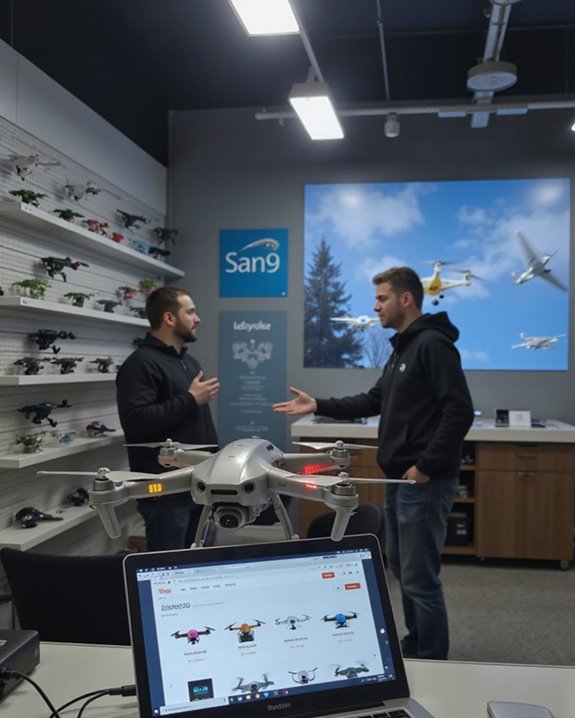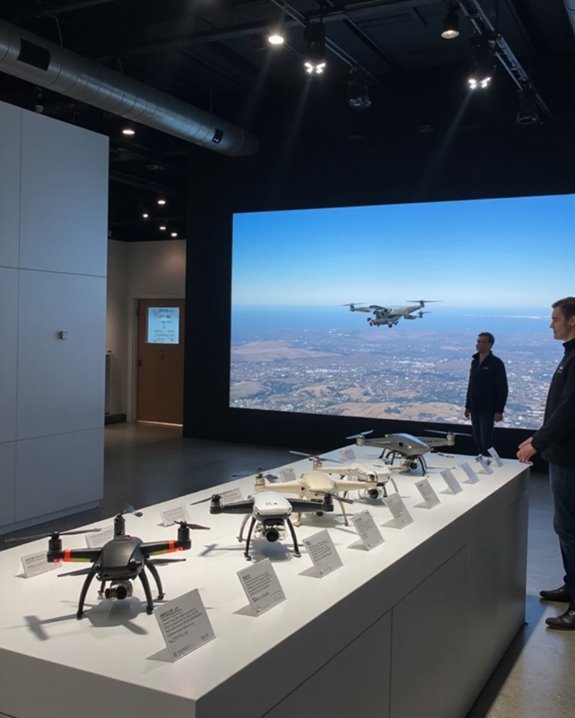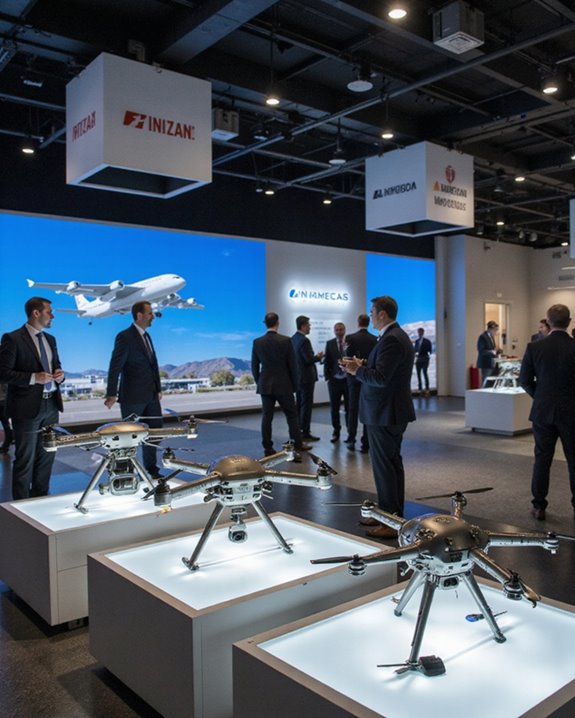Terrence Howard didn’t invent a drone, but he certainly made waves in the drone community! The Academy Award-nominated actor hosted a $25,000 drone competition in 2020, challenging builders to create six-motor designs with unique flight capabilities. While Howard promotes his theoretical “HAGAMOSphere” with an eight-propeller configuration, his claims about revolutionary tangential flight remain unverified by scientific standards. No patents or peer-reviewed research support his assertions, despite his enthusiastic promotion. The truth behind Howard’s drone ambitions reveals a fascinating intersection of celebrity and technology.
Key Takeaways
- Terrence Howard hosted and sponsored a 2020 drone competition with a $25,000 prize, but did not invent the winning design.
- Howard claims to have created the “HAGAMOSphere” drone with eight propellers, though no patents or peer-reviewed research validate this.
- The competition winner was Kevin Plaizier, who modified existing EmuFlight firmware to achieve the required flight dynamics.
- Howard served as a promoter and financial backer for drone development rather than as a technical inventor.
- Engineering experts have expressed skepticism about Howard’s drone claims due to theoretical flaws and lack of scientific validation.
Terrence Howard’s Foray Into Drone Technology
How did an Academy Award-nominated actor become involved in cutting-edge drone technology? Howard’s journey into the drone world began in 2020 when he hosted a competition with a $25,000 prize, challenging developers to build a six-motor drone capable of translating and rotating in any direction. The “Hustle & Flow” star didn’t invent drones himself, but his celebrity influence helped spotlight innovative drone design among FPV enthusiasts!
Kevin Plaizier, known as Quick-Flash, eventually claimed victory using EmuFlight firmware. Howard served as the competition’s sponsor and promoter, not its technical mastermind. While the actor has made some, shall we say, creative claims about various inventions, his actual contribution was providing funding and visibility for talented builders. The competition successfully energized the drone community, proving that sometimes Hollywood and hobbyist tech make surprisingly good partners. His involvement helped highlight the importance of FPV drone kits that balance camera quality, flight time, and ease of use for different experience levels.
The Lynchpin Drone: Understanding the Design
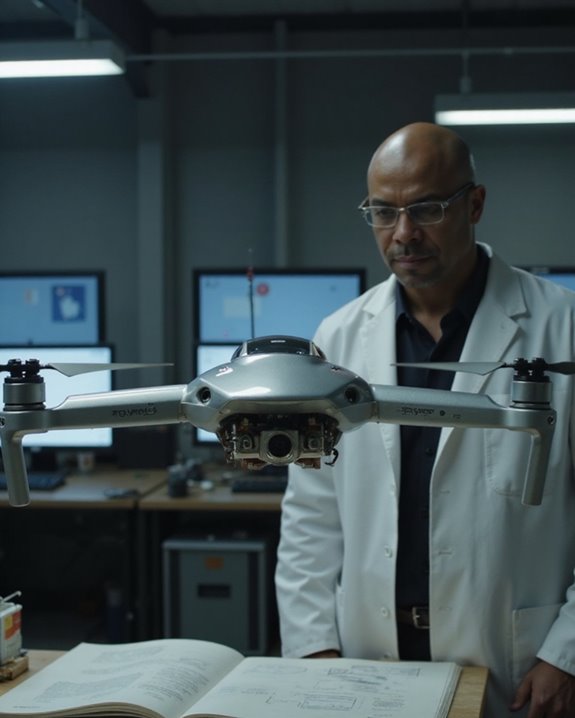
With Howard’s competition drawing talented drone developers, let’s examine what made the Lynchpin drone design so special! The six-motor configuration represents a genuine breakthrough in drone engineering, allowing for unprecedented maneuverability in any direction.
The Geometric Configuration of the Lynchpin drone is its defining feature, requiring a specific shape to achieve its unique flight capabilities. When Kevin Plaizier tackled this challenge, he focused on both stability mechanisms and innovative Material Selection to guarantee durability without sacrificing performance. Who would have thought what many deemed impossible would become reality in EmuFlight’s hands!
The drone’s construction required careful attention to aerodynamics, with each motor strategically placed to enable smooth translation and rotation. This technical achievement not only won the $25,000 prize but also demonstrated how creative problem-solving can push the boundaries of what’s possible in drone technology! The choice of motor KV ratings played a crucial role in balancing thrust and efficiency for optimal flight performance.
Tangential Flight: Breaking Down Howard’s Core Concept

Tangential flight, the groundbreaking propulsion system at the heart of Terrence Howard’s drone innovation, represents a fundamental shift in how aerial vehicles generate movement. Unlike traditional drones that rely on vertical lift from propellers, Howard’s concept harnesses lateral forces to create a more efficient flight pattern—truly a Movement Innovation worth noting!
The technology operates through sophisticated Force Harnessing techniques that utilize tangential momentum, resulting in improved stability and maneuverability. With 87 patents to his name, Howard’s background spans multiple scientific disciplines, making this concept particularly fascinating. His Linchpin Drone Company continues developing this technology that could revolutionize not just recreational drones but commercial applications too.
The most exciting part? Tangential flight might eventually extend beyond drones to transform broader aerospace sectors, though significant research challenges remain before widespread adoption becomes reality.
The $25,000 Challenge: Competition Results and Impact
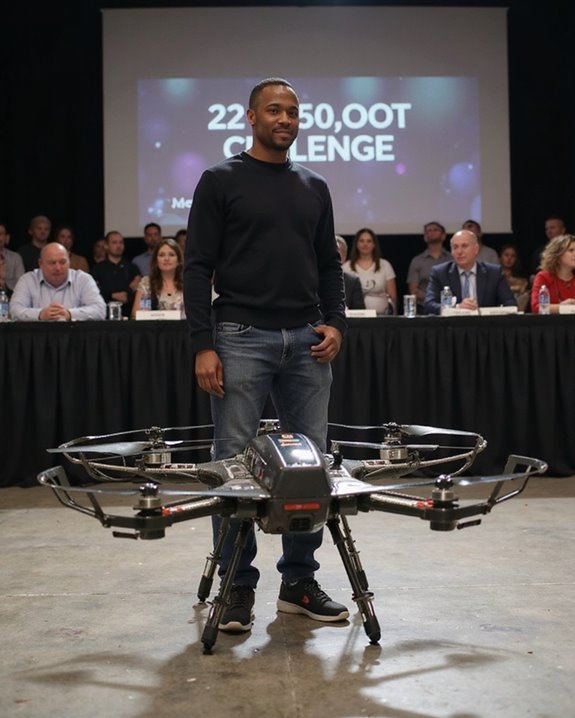
Terrence Howard’s $25,000 Lynchpin Drone Competition captivated the engineering community with its ambitious challenge to revolutionize aerial technology through unconventional design. The contest generated significant Media Buzz as contestants worldwide tackled the geometric puzzle of creating an omnidirectional drone based on Howard’s six-plane concept.
Electrical engineering student Kevin Plaizier claimed victory by successfully modifying EmuFlight software to achieve the required flight dynamics, walking away with the full prize. While no Sponsorship Deals emerged directly from the competition, its impact rippled through drone communities! The open-source sharing of designs and code democratized access to innovative flight technologies, turning what some viewed as Howard’s eccentric challenge into a genuine catalyst for engineering advancement. Who knew an actor’s geometric vision would inspire such practical innovation? This competition also highlighted the growing popularity and accessibility of DIY drone kits that cater to a wide range of skill levels and applications.
Scientific Evaluation of Howard’s Drone Theories

While the Lynchpin Drone Competition sparked genuine engineering innovation, the scientific community has approached Howard’s underlying theories with considerably more skepticism. His claims about electromagnetic forces and gravity relationships lack the Research Methodology typically required in scientific circles – namely peer review, replicable experiments, and mathematical proofs.
Physics experts have identified several Theoretical Flaws in Howard’s approach, particularly his conflation of gravitational and electromagnetic forces, which mainstream science treats as fundamentally different phenomena. You might wonder why this matters! Well, modern drone technology relies on well-established aerodynamic principles, not the radical electromagnetic concepts Howard proposes.
Without rigorous testing or documentation, Howard’s ideas remain closer to science fiction than legitimate scientific advancement. The drone industry continues to evolve through incremental, evidence-based improvements rather than revolutionary but unsubstantiated theories.
Comparing Lynchpin Technology to Conventional Drones
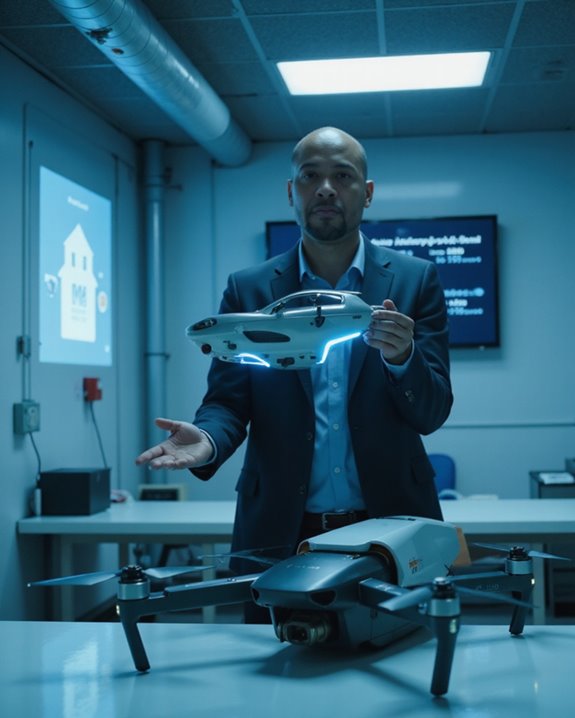
Looking beyond the controversy surrounding Terrence Howard’s scientific theories, the Lynchpin drone technology offers several fascinating differences when compared to conventional drones on the market today. The twelve-propeller configuration reportedly provides superior Flight Stability during complex maneuvers, allowing these drones to perform omnidirectional movements that traditional quadcopters simply cannot match.
Perhaps most intriguing is the potential Energy Consumption advantage through Howard’s proposed “tangential flight concept,” which might revolutionize how drones operate! When multiple Lynchpin units combine, they supposedly generate increased thrust capacity—imagine a drone swarm that could lift construction materials that would normally require heavy machinery. While conventional drones struggle with payloads and environmental challenges, the modular Lynchpin design adapts to various conditions with its scalable framework, offering an interesting glimpse into what drone technology might become.
Real-World Applications of Omnidirectional Drone Technology
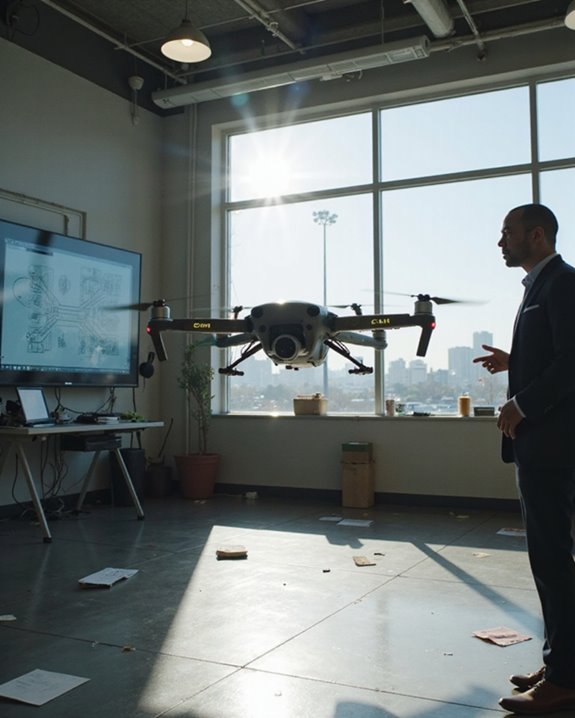
The revolutionary potential of omnidirectional drone technology extends far beyond theoretical discussions, creating tangible benefits across multiple industries today. Construction projects now employ modular drones that combine forces to lift heavy materials, replacing traditional cranes while improving safety and precision. During emergencies, these versatile aircraft deliver critical supplies to isolated areas and support search and rescue operations with unmatched efficiency!
Maritime Surveillance has been transformed by omnidirectional capabilities, allowing drones to hover steadily above choppy waters while inspecting vessels and monitoring coastlines. Event Coverage has never been more dynamic, with omnidirectional drones capturing smooth, continuous footage as they glide between angles without the jerky movements that plague conventional models. The HAGAMOSphere, with its innovative eight-propeller design, exemplifies how this technology continues to evolve for practical applications.
Community Response From Drone Enthusiasts and Builders
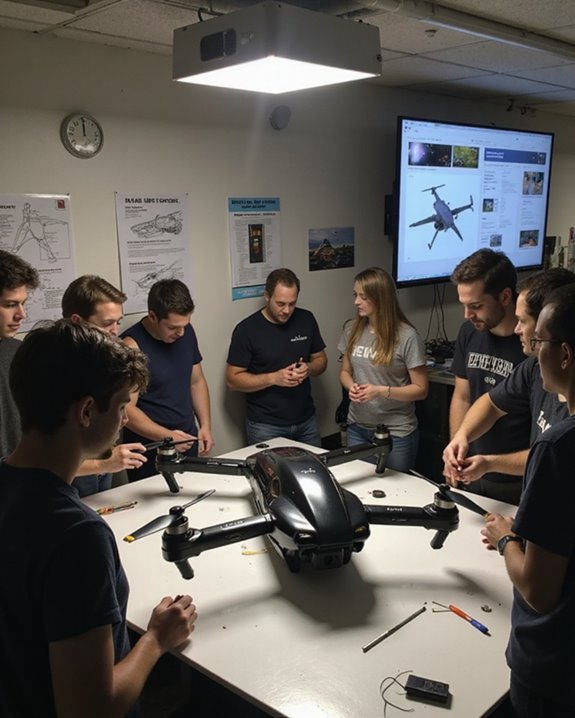
Drone enthusiasts across online forums and social media platforms have responded to Terrence Howard’s invention claims with a mixture of curiosity, skepticism, and technical criticism. Enthusiast Dialogues often revolve around the lack of supporting documentation, with many pointing to Howard’s abandoned patent application as evidence of unsubstantiated claims.
“Show us the math and working prototypes!” has become a common refrain in Builder Exchanges, where practical validation trumps theoretical concepts. While some hobbyists acknowledge that mathematically-driven flight control could be interesting, they require transparent engineering details before taking celebrity innovations seriously. Howard’s case has, ironically, sparked valuable community discussions about proper patent processes and the importance of peer review in drone tech! These conversations now serve as teachable moments for newcomers dealing with the difference between publicity and genuine technological advancement.
Separating Fact From Fiction in Howard’s Drone Claims
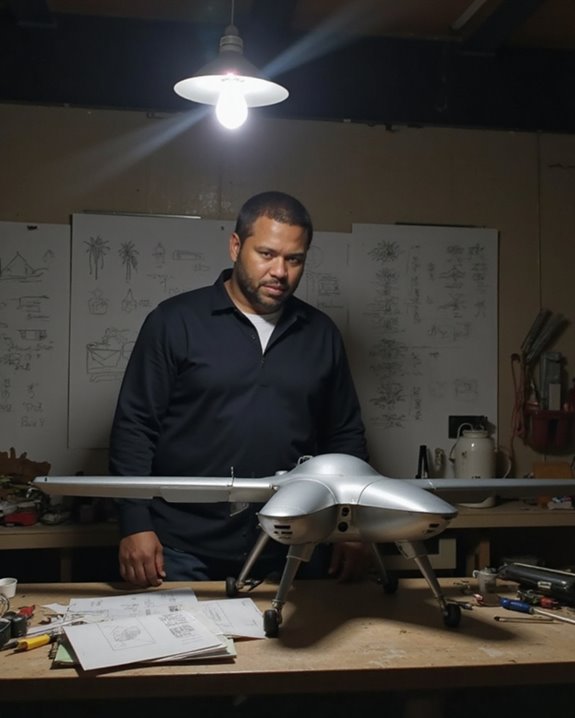
While drone enthusiasts debate technical merits, evaluating Terrence Howard’s actual contributions requires careful examination of his claims against verifiable evidence. The Myth Examination process reveals a significant gap between Howard’s assertions and documented achievements in aviation technology.
When conducting Fact Validation on Howard’s drone claims, we find no patents, peer-reviewed research, or industry recognition supporting his alleged invention. Instead, his statements often blend science fiction concepts with unverified mathematical theories that don’t hold up to scrutiny!
Howard’s background as an entertainer, rather than an engineer, further complicates matters. While his creative thinking certainly sparks interesting conversations, the lack of concrete evidence makes it impossible to credit him with genuine drone innovations. Remember, in technology, extraordinary claims require extraordinary proof—something currently missing from Howard’s portfolio.
The Future of Modular Drone Development
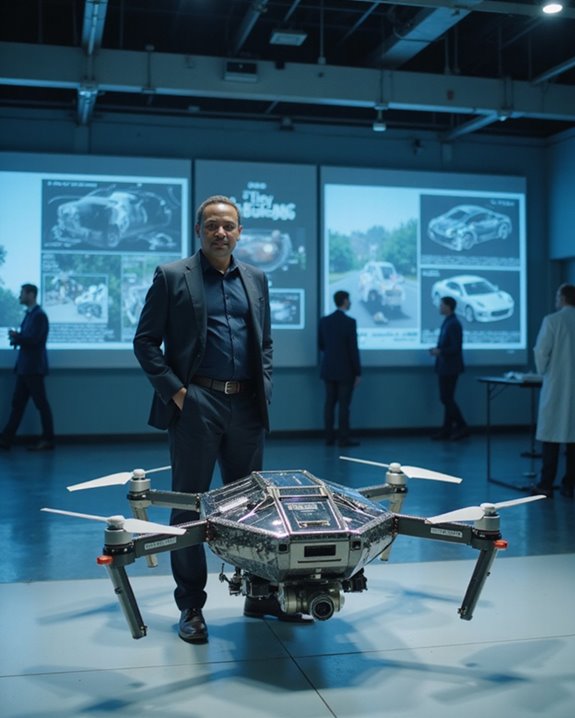
Emerging from today’s aerospace innovations, modular drone technology represents a revolutionary shift in how unmanned vehicles are designed, built, and deployed across industries. These adaptable systems allow for quick component swapping and mission-specific configurations without rebuilding entire aircraft!
The integration of AI processors into modular frameworks has transformed operational capabilities, enabling drones to make split-second decisions based on real-time data analysis. Imagine a drone that can predict its own maintenance needs before problems occur! Meanwhile, Sustainable Energy solutions, from next-gen batteries to solar panels, are extending flight times by up to 30% while reducing environmental impact.
For both military applications and commercial uses, the standardization of interfaces is creating an ecosystem where innovation happens faster, costs decrease, and capabilities expand exponentially.
Frequently Asked Questions
What Is Terrence Howard’s Educational Background in Engineering or Physics?
Terrence Howard’s educational path includes studying chemical engineering and applied materials at Pratt Institute, but he did not complete his degree. His physics qualifications remain informal, without any formal degrees in engineering or physics.
Has Howard Secured Patents for His Drone Technology Innovations?
Amidst a whirlwind of patent disputes, there’s no concrete evidence that Howard has secured specific patents for drone technology innovations. His 94 patents span various fields, but none definitively demonstrate drone-specific innovation impact.
Are Any Major Aerospace Companies Investing in Howard’s Drone Concepts?
No major aerospace companies have publicly invested in Howard’s drone concepts. Current company interest remains limited, with investment trends showing his innovations have mainly circulated within hobbyist communities rather than commercial aerospace sectors.
How Much Personal Funding Has Howard Invested in Drone Development?
Specific figures on Howard’s personal investment remain undisclosed. Reports indicate substantial personal resources allocated despite funding challenges. The unconventional nature of his drone concepts creates uncertainty regarding potential investment returns in aerospace applications.
Did Howard Collaborate With Academic Institutions on His Drone Research?
Adrift in a sea of solo innovation, Howard’s drone research lacks documented institutional ties. Public records reveal no formal collaboration benefits from academic partnerships, with his work developing independently of established research communities.


